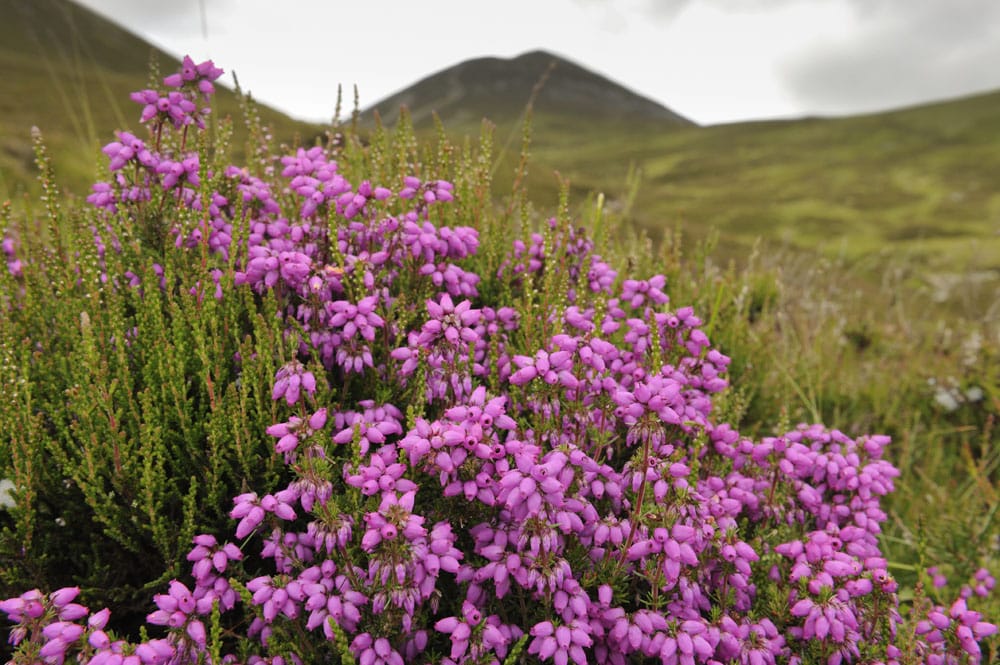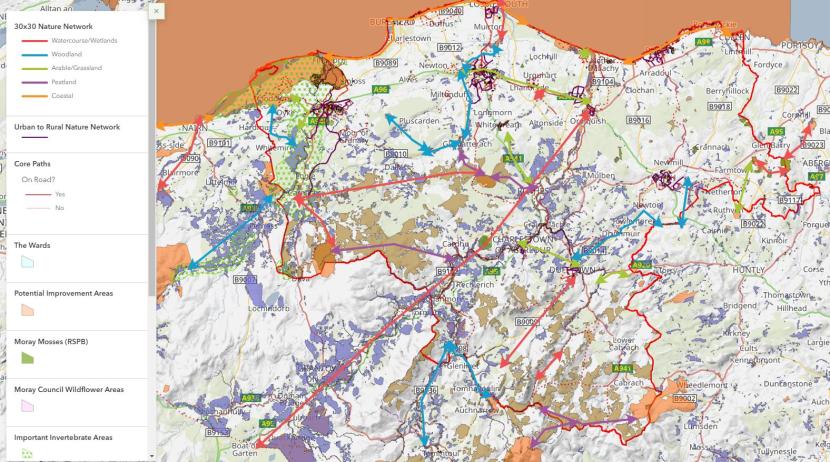Delivery Partners
Consultant: Envirocentre
Core advisory group: Moray Climate Action Network, NatureScot, Scottish Forestry, Findhorn Nairn and Lossie Rivers Trust, Findhorn Watershed Initiative, Spey Fishery Board, Spey Catchment Initiative, Moray Firth Coastal Partnership, Joint Community Councils of Moray
Timescale
Funding and costs
£35,000 from the Nature Restoration Fund direct grant to local authorities
Project summary
This project is the first stage of creating a Nature Network for Moray, a predominantly rural area and small local authority with diverse landscapes stretching from the Moray Firth coast to the Cairngorm mountains.
The aim is to produce a spatial opportunity map to sit within the Local Development Plan (LDP) and form the foundations of a local governance structure that will continue into the delivery phase.
The additional Nature Restoration Fund (NRF) allocation in 2023/24 enabled the council to commission an ecological consultant to undertake engagement and develop an evidence based opportunity map that a) links designated (30×30) sites with similar or complimentary features and b) connects nature within urban areas and outward to the designated sites using existing natural features or opportunities such as active travel routes.
Governance and decision making
A core advisory group was formed at the very start, comprising of:
- Community representatives (Moray Climate Action Network and Joint Community Councils)
- Landscape scale environmental charities (Moray Firth Coastal Partnership, Findhorn Nairn & Lossie Rivers Trust, Findhorn Watershed Initiative, Spey Fishery Board and Spey Catchment Initiative)
- Statutory bodies (Moray Council, NatureScot and Scottish Forestry)
The purpose of this group was to: guide, and provide local/expert knowledge in spatially identifying the Nature Network; support bottom up design and delivery of the Nature Network through connecting with communities; feed back to regional and national groups where appropriate.
Though initially it is an informal group formed to steer the spatial mapping and related engagement, it has the potential to grow into a Local Nature Network Group that guides delivery of the Nature Network in future.
Participation, engagement and communication
Stakeholders were involved early on, with a series of workshops and meetings aiming to introduce the concept as well as identify opportunities and constraints. A Story Map showing the draft Nature Network was published early in this process to guide and inform feedback, this was published on the council’s website and sent to targeted groups alongside a survey. The feedback received through the engagement process has informed the final map routes and accompanying report.
In recognition that Nature Networks involve connecting people with nature, council owned land and core paths were highlighted as opportunities to enable the council to play a leadership role in delivery role (mainly within urban areas).
Knowledge and skills
The core group and wider stakeholders consulted represent a diverse range of local knowledge and experience, including those who have been working on landscape scale nature restoration in the area for many years.
Moray Council representatives guiding the project have sought to align the Nature Network with other policy and strategies that address climate change, forestry and green skills.
Liaising with NatureScot at key points gave the project confidence and provided mutual learning opportunities.
Data, mapping and monitoring
The opportunity mapping has involved desk based analysis of available data sets such as native woodland and peatland, alongside local stakeholder input. Each connection has been individually drawn and considered within the context of nearby features.
Future work will involve incorporating ecological survey data to the map. This will build evidence of sites that are already nature-rich or with active or potential restoration, so that resources can be directed to where they can achieve meaningful impact.
It is acknowledged that the map will be dynamic, with the potential for connections to move should opportunities or barriers emerge.
It is the intention that these decisions would be made by the core group.
Finance and resourcing
The NRF grant was pivotal in enabling the spatial map to be produced in good time for the LDP. With no ecological expertise within Moray Council, and no existing biodiversity partnership focused on Moray (the North East Scotland Biodiversity Partnership covers three local authority areas and is not resourced to lead this work), ecological consultancy was required.
Future resourcing of the delivery phase is still being considered, but it is recognised that this will require access to variety of finance options.
Policy and Mainstreaming
This project has raised awareness and understanding of the Nature Networks concept in Moray. Significant engagement with key stakeholders is starting to forge links across policy areas including development planning, forestry and climate change.
Planning guidance is being developed that will support delivery of biodiversity enhancements that contribute to the network. The actions required to deliver the Moray Nature Network on a wider scale will be embedded within Moray’s first Biodiversity Strategy, due for publication in 2025.
Key benefits and improvements
- Fully mapped Nature Network opportunities, covering both the urban and rural landscape, will be finalised in time for the proposed LDP.
- A core group has been convened and there is interest from a wider range of stakeholders to take delivery forward.
- Increasing alignment across policy and workstreams, early actions are maximising co-benefits.
Moray Nature Network will provide focus and structure to forthcoming Biodiversity Strategy.
Challenges and barriers overcome
Lack of capacity within the council and partners continues to present a challenge, and with no existing local nature recovery plan or strategy in place the decision was made to direct some of the additional NRF funding in 2023/4 to the development phase of a Nature Network.
As one of the first planning authorities in Scotland to go through the new style LDP process, and with the additional NRF funding in 2023/24, there was a degree of urgency to progress this work without waiting for the AECOM tool to become available. However, the approach taken by the consultants, while time consuming, has produced a high quality opportunity map and the other elements of the AECOM tool will be explored over the next year.
The newness of the concept, along with the scale and character of the rural network, resulted in lower engagement than hoped. Fortunately, connections were made later in the process, particularly relating to agriculture, and as the network will be adaptable it is intended that these relationships and information will grow over time.
There is no delivery plan for the Nature Network yet, and the limited capacity within the council to facilitate bottom up delivery is likely to persist. Close collaboration with partners in the community, including Moray Climate Action Network, the North East Scotland Biodiversity Partnership and those working on landscape scale nature recovery will be important to the success of the Nature Network. Relationships between these groups are growing and it is hoped this will form the foundation of a supportive framework to facilitate delivery in future.
Find out more
Help us build a useful toolbox
Share your feedback on existing guidance and resources, as well as links to others you think would be useful. We’d also love to hear about any great Nature Network projects that we should showcase.
.

